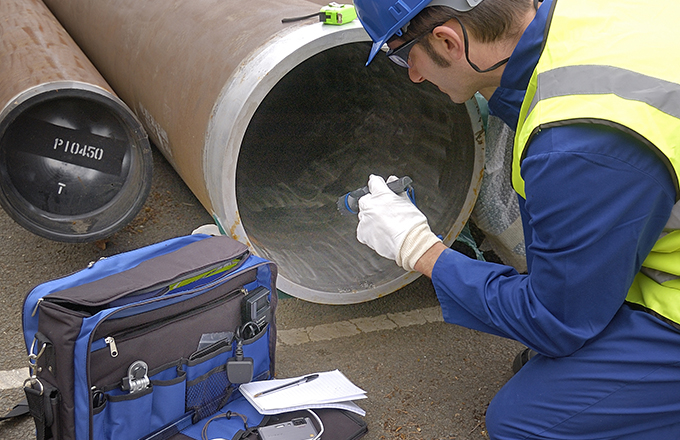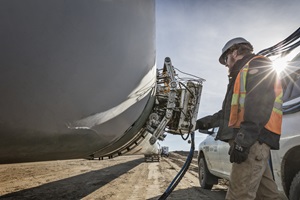Pipeline Welding Inspection: Ensuring Safety and Quality in Every Weld
Pipeline Welding Inspection: Ensuring Safety and Quality in Every Weld
Blog Article
Advanced Strategies in Pipe Welding Assessment: Innovations and Technologies for Improved Precision and Integrity in Weld Analysis
The landscape of pipeline welding assessment is going through a substantial transformation, driven by advanced techniques that promise to improve both precision and reliability in weld analyses. Advancements such as automatic assessment systems and advanced imaging innovations are redefining traditional methods, while non-destructive testing techniques guarantee product stability is preserved. As these technologies develop, they not just raise defect discovery prices but additionally make it possible for much more reliable upkeep methods. However, the ramifications of these advancements prolong beyond immediate benefits, increasing essential inquiries regarding future methods and standards in the industry.

Significance of Weld Examination
Ensuring the stability of pipeline welds is vital to the overall safety and integrity of commercial systems. Extensive examination of welds is integral to the lifecycle of pipe framework.
The value of weld examination extends past simple compliance with governing requirements. It acts as an aggressive procedure to recognize and remedy blemishes, such as incomplete combination, porosity, or splits, before they escalate right into major problems. Reliable assessment methods additionally add to the durability of pipes, lowering upkeep expenses and improving functional effectiveness.
In addition, detailed weld assessments foster trust amongst stakeholders, including regulatory bodies, financiers, and the neighborhoods offered by these pipelines. By ensuring that all welds satisfy the called for requirements, companies can mitigate risks and maintain their track records. In recap, weld inspection is important not just for functional stability but likewise for the wider implications it holds for security and environmental stewardship.
Automated Inspection Solutions
The combination of automated inspection systems in pipe welding has changed the method to making certain weld top quality and honesty. These systems utilize advanced robotics and man-made knowledge to carry out inspections that are not just faster but also more consistent than traditional methods. Automated systems can cover extensive sizes of pipelines effectively, recording data that human examiners may overlook because of exhaustion or ecological conditions.
One of the crucial benefits of automatic examination systems is their ability to run in dangerous environments, decreasing the risk to human examiners. They make use of numerous non-destructive testing (NDT) techniques, such as ultrasonic screening and magnetic particle inspection, to assess weld stability without endangering the framework. The data accumulated is processed in real-time, enabling immediate feedback and timely rehabilitative activities when problems are determined.
Moreover, automated systems facilitate the standardization of examination processes, ensuring that each weld is examined against constant standards. This not only improves the integrity of results however likewise simplifies compliance with regulatory criteria. As sectors remain to prioritize safety and functional performance, the role of automated examination systems in pipe welding will most certainly broaden, leading the way for extra sophisticated quality guarantee approaches.
Advanced Imaging Technologies
Regularly utilized in modern-day pipeline welding evaluations, advanced imaging modern technologies have actually significantly boosted the capability to discover and assess weld flaws. Techniques such as digital radiography, calculated tomography, and thermographic imaging give assessors with high-resolution images that disclose sub-surface imperfections and structural disparities that may be unseen to the naked eye.
Digital radiography utilizes electronic sensing units to capture pictures, permitting instant testimonial and boosted picture contrast. This results in much faster inspections and enhanced accuracy in identifying crucial issues. Computed tomography, on the other hand, supplies three-dimensional imaging, making it possible for examiners to visualize intricate geometries and evaluate the integrity of welds from numerous angles - Pipeline Welding Inspection. This depth of analysis is very useful for spotting problems that typical methods might forget.
Thermographic imaging employs infrared modern technology to find variations in temperature level, identifying areas of potential weakness or anxiety within the weld. These advanced imaging innovations not just enhance issue discovery prices yet also reduce the moment and sources required for pipe assessments. Therefore, they play an important duty in preserving pipe safety and reliability, making certain compliance with sector criteria while lessening operational threats.
Non-Destructive Evaluating Methods
Using various techniques, non-destructive testing (NDT) methods are important in pipeline welding inspections, allowing for the analysis of weld integrity without jeopardizing the material's structural integrity. NDT includes an array of techniques, consisting of ultrasonic testing (UT), radiographic testing (RT), magnetic fragment testing (MT), and dye penetrant screening (PT) Each approach has distinct advantages and go to this website applications depending on the certain requirements of the examination.
Ultrasonic screening uses high-frequency acoustic waves to find interior imperfections, providing exact dimensions of weld thickness and stability. Pipeline Welding Inspection. Radiographic testing employs X-rays or gamma rays to produce photos of the weld, disclosing internal issues that might not be visible on the surface. Magnetic particle screening is efficient for detecting surface and near-surface suspensions in ferromagnetic products, while color penetrant screening highlights surface area splits by using a tinted dye
Including these NDT techniques right into pipeline welding evaluations boosts the accuracy and dependability of weld evaluations, guaranteeing that possible failures are determined early. As industries demand greater criteria for security and performance, the role of NDT in preserving the integrity of welded frameworks remains to be essential in pipe building and construction and maintenance.

Future Fads in Weld Evaluation
As we aim to the future of weld assessment, improvements in modern technology are positioned to change the techniques employed for evaluating pipe stability. The integration of fabricated knowledge (AI) and maker discovering in inspection processes is anticipated to improve the precision of defect discovery and predictive maintenance. These innovations enable real-time information analysis, allowing inspectors to identify prospective problems prior to they rise right into significant issues.
Additionally, making use of drones furnished with innovative imaging systems is obtaining traction. These aerial assessments can cover huge areas rapidly, recording high-resolution pictures and information that can be assessed for problems in hard-to-reach areas. This not only improves safety yet likewise raises effectiveness in the assessment process.
Moreover, the advancement of clever sensing units installed in pipe systems provides the capacity for continuous tracking. These sensors can discover modifications in pressure, temperature, and vibrations, providing valuable insights right into the health check out here of the welds over time.

Final Thought
In final thought, the combination of sophisticated techniques in pipe welding evaluation considerably boosts the accuracy and integrity of weld evaluations. Innovations such as automatic examination systems, progressed imaging modern technologies, and non-destructive screening approaches play an important role in enhancing issue discovery rates and fostering aggressive upkeep strategies. As these innovations remain to develop, they will certainly further make certain the safety and security and efficiency of pipe systems, ultimately adding to the integrity of vital facilities.

Report this page